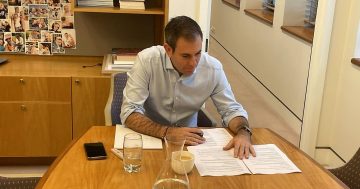
Construction underway at the Boulevard apartment development in Denman Prospect, bringing more people to the growing suburb. Photo: LJ Hooker.
The number of people living in the ACT increased by 3134 in 2021-22, the latest Australian Bureau of Statistics (ABS) regional population data reveals, with growth particularly high around Canberra’s outer suburbs.
According to the data, based on revised estimates from the 2021 Census, the ACT’s population stood at 456,692 in June 2022 and grew by 0.7 per cent over the financial year.
In total, Australia’s capital cities increased their population by 1.2 per cent, putting Canberra slightly below the average.
The areas with the largest growth were Denman Prospect (up by 740 people) in Canberra’s outer west, Throsby (up by 540 people) in Canberra’s outer north and Strathnairn (up by 330 people) in Canberra’s outer north-west.
Looking at the highest growth rates in ACT suburbs, the results were similar: Denman Prospect, up 27 per cent over the 12 months; Throsby (23 per cent); and Taylor (14 per cent).
The ”centre” of the ACT in terms of population distribution was in Lake Burley Griffin, west of Acton, as of 2022. It moved 30 metres north over 2021-22, reflecting slightly stronger population growth in the northern suburbs.
This follows a trend we have seen over the past decade – between 2011 and 2021, the centre of the ACT moved 1.3 kilometres north as the northern suburbs expanded.
The suburbs with the highest population density were Kingston (4900 people per sq km), Braddon (4800 per sq km) and Civic (3500 per sq km).
The ABS’s regional population data also included details of the age and gender of the ACT’s population.
The ACT had a younger age distribution than Australia as a whole, reflecting the number of young people who moved to Canberra for work or study.
People aged 20 to 39 accounted for 33 per cent of the territory’s population, compared with 28 per cent of Australia’s population.
The areas with the youngest populations were: Acton, with a median age of 19.9, due to the high number of students living in the area; Duntroon, with a median age of 21.1 years; and Civic, with a median age of 27.
The areas with the highest median age were Yarralumla (50.2 years), Isaacs (49 years) and Canberra East (47.4 years).
In 2021-22, natural increase (3300 people) and net overseas migration (3200) were positive contributors to Canberra’s population increase, but net internal migration was negative (-3300).
The largest natural population increase was recorded in the northern suburb of Ngunnawal, which grew by 150 people.
Denman Prospect had the largest net internal migration gain, at 670.
The largest net overseas migration gain, at 140, was recorded in Belconnen town centre.
The ABS also released updated data on the demographic breakdown of states and territories.
According to the data, as of 2022, the ACT had a lower age distribution than Australia as a whole, reflecting the number of young people moving to Canberra for work or study.
People aged 20 to 39 accounted for 33 per cent of the territory’s population, compared with 28 per cent of the country’s total population.
The ACT also had a lower median age (35.4 years) than Australia as a whole (38.4).
Some areas had a particularly young population: the areas with the lowest median age were Acton (19.9 years), due to the large student population; Duntroon (21.1 years), due to the Royal Military College; and Civic (27 years).
The areas with the highest median ages were Yarralumla (50.2 years); Isaacs (49 years); and Canberra East (47.4 years), which contains Symonston, Harman, Beard and Oaks Estate.





















